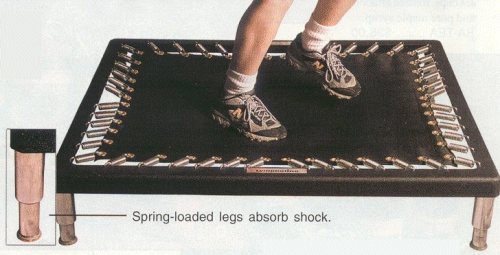Inversion and Pronation - the biggest problem people have with rebounding
A rebounder that has too much deceleration that "cones" in too much can really hurt my ankles and knees. Some springs are not tapered or they have too many coils between the tapers so that all the coils are active and decelerate the mat too much causing the mat to cone inwards. This is why the short springs don't usually have inversion problems (Lymphaciser, Lympholine, and Urban). The problem is that they can be jarring.
The Cellerciser has 3 different tiers so that if the person is very light then the other 2 tiers of springs remain inactive. If too many coils are active without a taper in between, it can just keep stretching till the weight of the person stops the spring from stretching. The Cellerciser spring has the most coils of all the springs I have used but only 11 coils are being used during the Health bounce and the first taper springs them back up. The springs that usually invert have about 15 to 20 coils that are active the whole time. The New Cellerciser spring has 23 coils and a heavier person will 3 or 4 more coils to adapt to their weight and a very heavy person will use all 23. This is how it adjust to the person's weight and gives everyone an equal bounce. So, if a family is using the rebounder, you don't have to buy several rebounders for different weights.
The Needak has 2 rebounders for different weights. The Soft Bounce is for lighter people while the Hard Bounce version is for much heavier people. This is a more customized way of buying a rebounder. This is the only company that I found to separate the rebounders for different people. If a really heavy person jumps on a rebounder that is made for lighter people then it can the tensile strength out of the spring and it will have to replaced much sooner. The Lymphaciser has virtually no inversion at all. It is my favorite rebounder for just doing the Health Bounce but not for heavy people. The Lympholine was my favorite rebounder before the Cellerciser and I used the Lymphaciser.
With rebounders that are not the right one, people can find they have to stand on the outer edge of the rebounder do to a rebounder that has too many active coils before the taper. Many people find they have to supinate their feet (bounce on the outer edge of their foot) to stop their foot from pronating inwards. The right rebounder should allow a person to jump with their feet shoulder width apart and not have their feet cock inwards. I have seen people too many times jumping with their legs angled and their feet too close to the edge of the mat so their feet don't invert. This is when many people buy a rebounder and want to return it when it starts hurting their knees due to jumping at at an angle.
Note: all rebounders have a gravitational pull towards the center. Heavier people have a greater pull. Buying the right rebounder based on your weight and rebounding goals will help avoid any problems. Take my rebounder quiz and I will help pick out a rebounder based on your answers.
Rebounder Inversion
I will find which rebounders have the most edge role pressure that make my feet turn inwards. I will see which rebounder lets me jump with my feet flat and forward and not angled upward to avoid inversion. I will measure the lateral displacement from the center to see which gives me the largest sweet spot area to jump in before my feet cock inwards.
PIcture of you what the feet look like with no inversion
Take the Rebounder Quiz and get a rebounder based on your answers
DISCOUNTREBOUNDERS.COM
Guide to choosing Lymphatic Rebounders
We're open now
1-877-354-3778
Ask for Jayden
We're open now
1-877-354-3778
Ask for Marco
DiscountRebounders.com
Got Rebounding Questions? Call 1-877-354-3778. Ask for Jayden, Sharon, Marco, or Ronny
We're open now
1-877-354-3778
Ask for Sharon
We're open now
1-877-354-3778
Ask for Ronny

















